Ontario
| |
 |
Toronto |
Ontario |
Canada |
Horizontal Dial |
Dial 433 |
| A striking 30 inch diameter horizontal dial. The equation of time correction is made by a slight rocking of the gnomon about the polar axis, controlled by a manual date index and a hidden cam mechanism. At the south end of the gnomon on the dial is a sunburst design. The octagonal pedestal is ornately covered with six copper plates. Each showing two zodiac signs in relief, forming a frieze 20 inches high around the pedestal. |
| |
| |
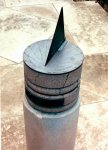 |
Toronto |
Ontario |
Canada |
Horizontal Dial |
Dial 435 |
| A small bronze 8 inch diameter horizontal dial, sitting upon a granite column of equal diameter. The dial plate has simple radiating hour lines and Roman numerals. No minute or quarter hour marks. The gnomon may have broken off at some time and been repaired, since it is now held on by a rather unsightly bronze angle iron. |
| |
| |
|
Toronto |
Ontario |
Canada |
Horizontal Dial |
Dial 128 |
| Approx 55 ft square Stone (concrete?) 4AM-8PM marked in Arabic numerals, half and quarter hours marked with lines. A huge dial. The gnomon is sunk below the outer level by a series of steps. The hours are marked by stone slab 'seats' spaced around the outer square. There are two seats at the noon position to allow for the width of the gnomon. This dial no longer exists. |
| |
| |
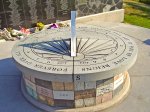 |
Toronto |
Ontario |
Canada |
Horizontal Dial |
Dial 596 |
| A 210 cm diameter horizontal dial of blue granite with a 56 cm high stainless steel gnomon. In addition to showing local time, the declination line that touches the base of the gnomon traces the path of the shadow on June 23 (date of the 1985 Air India terrorist-bomb air crash) and also marks solar noon at the crash site near Akahista, Ireland where there is a similar memorial sundial. Stones forming the pedestal represent all of the Provinces and territories of Canada, and the countries of India, Ireland, Japan and the United States of America. |
| |
| |
 |
Torre |
Coahuila |
Mexico |
Analemmatic Dial |
Dial 509 |
| An analemmatic dial with major axis of 18 feet built of many different types of stone from the Torre?n Jard?n area, including white and red marble, travertine, yellow and black flagstone, and limestone. Insets of gray stone hold the hour markers from 5am to 7pm. The finished dial has been set in desert plants, native to the region, including: Candelilla, Gobernadora, Lechuguilla, Sangre de drago, Huevo de toro, Biznaga, Pitaya, Corona de espinas, Nopal rastrero, and Cardenche. These are all protected desert species. The dial has a compass rose and six disk-shaped maps at the east and west sides to show the course of sunrise/sunset across the Mexican Republic on the solstices and equinox. |
| |
| |
|
Torreon |
Coahuila |
Mexico |
Vertical Dial |
Dial 487 |
| This is a stone cube 3.5 m high with four vertical dials. Each dial face is about 2.2 m high by 1.25 m wide The South and North faces have Arabic numerals to indicate solar time from 6am to 18hrs, with marks every 15 minutes. The East face has numerals from 6am to 12pm and the West face complements from 12pm to 18hrs. These faces have half hour marks. The South face has seven declination lines, constellation dates, analemma line, zodiac symbols, and equinoctial and solstice lines. A curve to indicate light and shadow hours all the year is on each face. A square base on quarry. At the north-east corner are the carved names of the designer Miguel Bertran de Quintana and builder Cirilo Nunez.
Note: because of the sundial size and latitude, it was necessary to extend the four vertical faces of the sundial into the horizontal plane to indicate the summer solstice line and 11:30 and noon hours of summer. |
| |
| |
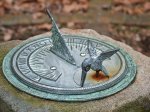 |
Towson |
Maryland |
USA |
Horizontal Dial |
Dial 334 |
| A bronze horizontal dial made inscribed "1715". About 10 inches in diameter with an ornately decorated dial plate.
The original gnomon has been removed and a modern garden sundial placed over the original dial face; little of the original face is visible. The dial is on a square stone that sits atop a plane square cut stone pillar. |
| |
| |
 |
Traverse City |
Michigan |
USA |
Analemmatic Dial |
Dial 494 |
| This beautiful analemmatic dial was built as part of the American Society of Landscape Architects' 100 years/100 Parks project. A colored concrete pad was poured on the north/south axis and scored joints for each month. Stainless steel plates show the name of the months. On either side of the concrete pad are dry laid flagstones with creeping thyme in the joints. Hour markers are 12 inch diameter colored concrete bases with numbers cut from stainless steel. A stained glass sun plaque at the top of the month axis was made by a local artisan. Total dial size is about 10 x 20 feet. |
| |
| |
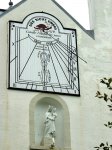 |
Trois Rivieres |
Quebec |
Canada |
Vertical Dial |
Dial 66 |
| A declining vertical dial approximately 6 feet wide and 8 feet tall of painted wood. Diol declines 58? west of south. Dial includes a two-lined analemma noon mark that shows noon corrected for EOT. Hour lines with Roman numerals show local time from 10 AM to 7 PM. Dial is located about 30 feet high on a wall, above an alcove with a statue of the Virgin Mary. The gnomon length is correct for the shadow of the tip to fall on the noon mark. Dial furniture includes a lunar crescent and a depiction of a beaver carrying a tree branch, in a classic French tradition and similar to dials of Zarbula's overall design. |
| |
| |
 |
Tucson |
Arizona |
USA |
Equatorial Dial |
Dial 4 |
| A bronze equatorial dial approximately 2 ft. in diameter designed by R. Newton Mayall. Mayall stated, "When I was asked to design the sundial in front of the Museum at Kitt Peak I was more than pleased, for it gave me a chance to work a semblance of astronomy into it. The design reflects the great telescope nearby, with its base and fork type mounting, the dial itself being the "telescope"." |
| |
| |
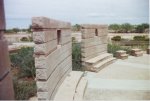 |
Tucson |
Arizona |
USA |
Sun Alignment |
Dial 11 |
| A "Stonehenge" or sun circle dial designed by Chris Tanz, Susan Holman, Paul Edwards and with the help of Will Grundy and sponsored by the Pima County Flood Control and Transportation Dept. The structure uses a broken circle of walls to create designs made of light based on the movement of the sun. The circle, 50 feet in diameter with 8 foot walls is modeled loosely on the Casa Rinconada kiva ruins in Chaco Canyon, N.M. The walls are of integrally colored concrete block, concrete, and flagstone. Lines on a bronze plaque indicate north and south and the direction of sunrise and sunset on the equinoxes and solstices. Holes in the wall do the same. Solar noon is marked when sunlight comes through a slot in the South wall and passes a line on the floor. |
| |
| |
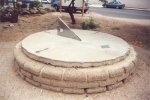 |
Tucson |
Arizona |
USA |
Horizontal Dial |
Dial 12 |
| This concrete and adobe brick horizontal dial is approximately 8 1/2 feet in diameter with a triangular gnomon 25 x 32 inches. This is a large, but very plain sundial except for the shiny chrome plated gnomon. It lacks numerals, but has hour points and shows the cardinal points. The dial is corrected for longitude. The pedestal is missing some bricks and is adorned with graffiti. |
| |
| |
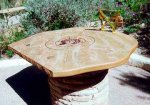 |
Tucson |
Arizona |
USA |
Horizontal Dial |
Dial 14 |
| A 25 inch circular engraved horizontal dial in a large irregular stone. Surrounding the dial on the stone are zodiacal signs and a beautiful engraved drawing of the surrounding mountains. The designer, John Carmichael, calls these dials "horizontal string heliochronometers" since the gnomon is a brass cable held very straight under tension from a heavy counterweight which is suspended from a brass hinged lever. |
| |
| |
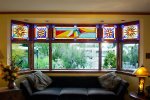 |
Tucson |
Arizona |
USA |
Vertical Dial |
Dial 533 |
| A declining vertical stained glass "Gecko" sundial 58 x 20 inches consisting of 153 colored glass pieces and exterior rod gnomon with triangular base. Paintings on 11 glass pieces use vitreous kiln-fired enamels and stains. Dial and four adjacent panels consisting of 540 glass pieces are set in bay window overlooking succulent garden containing additional sundials. Dial glass panel includes painting of a Tucson Banded Gecko stalking fly, a star field, sun face and solar noon mark. Dial declines 27.4? east of south. Contact owner John Carmichael to arrange viewing. |
| |
| |
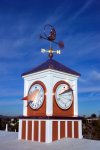 |
Tucson |
Arizona |
USA |
Vertical Dial |
Dial 544 |
| Four vertical dials on the faces of a 100-inch tall redwood cupola on the roof of a private residence. The 21-inch dial faces are kiln-fired porcelain on steel; the bezels and gnomons are copper. The dials are longitude corrected for MST. Three dials have solar noon marks. |
| |
| |
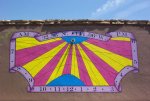 |
Tucson |
Arizona |
USA |
Vertical Dial |
Dial 566 |
| A vertical 44x92 inch dial declining 4.53? east of south painted on the rough textured stucco wall of a private home. The 2x4 inch tall conical horizontal gnomon is gold plated brass. The dial face is hand painted with elastomeric acrylic exterior house paint. The horizontal conical gnomon optimizes the nodus shadow at the location low latitude to show time and date. Dial face shows date/declination lines, solar noon mark and hour, 1/2-hour and 15 minute lines. To arrange viewing, contact owner Christina McVie. |
| |
| |
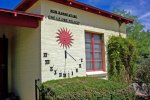 |
Tucson |
Arizona |
USA |
Vertical Dial |
Dial 579 |
| Located on a side street wall of a private home, this 4x6 foot due south vertical dial uses welded iron numerals and gnomon. Built in 1954, this is the oldest known sundial in Tucson. Designed using Mayall and Mayall's "Sundials" and described in detail in April, 1954 Home and Garden Magazine. |
| |
| |
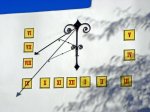 |
Tucson |
Arizona |
USA |
Vertical Dial |
Dial 711 |
| An 84x47 inch vertical dial declining 18? east of south on the outside wall of a private residence. Roman hour numerals are on 8 inch square hand-painted ceramic tiles. The gnomon and support are welded wrought iron painted black. A hand painted EOT graph is shown on a matching ceramic tile.
This is a historic home designed by southwestern architect Josias Joesler. Homeowner found original architectural drawings showing a gnomonically-flawed sundial that was never installed and contacted John Carmichael to design this accurate new dial. |
| |
| |
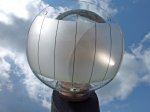 |
Tucson |
Arizona |
USA |
Globe or Hemispheric |
Dial 735 |
| A fused silica glass spherical lens projects a solar image spot onto the inner surface of a spherical segment of glass with a frosted area inscribed with hour lines and Arabic hour numerals. Time is read from the bright spot of light on the frosted surface while standing under the dial. Dial is mounted atop a pipe pillar on the patio of the Visitor Center. |
| |
| |
 |
Tucson |
Arizona |
USA |
Sun Alignment |
Dial 1039 |
| The Vista Sun Wheel is 63 feet [19.2 m] outside diameter and 197 feet [60 m] in circumference. The Wheel is composed of 28 tons of broken limestone. The central cairn is 11 feet [3.4 m] in diameter and 3 feet [1 m] high. In the center is a post marked by a sandstone block about 30 inches [76 cm] tall. The floor of the Sun Wheel called for another 28 ton of crushed decomposed red granite about 3/4 inch [2 cm] thick. Stone spokes indicate the solstices and equinox. Other stones 30-40 inches [75-100 cm] are set to various alignments outside the ring. A post indicates the setting sun on Groundhog Day, indicating one of the cross quarter days. The layout was made by direct observation, watching the progress of the sun along the horizon to solar standstill then return. 18 months were required to observe, mark and verify positions then setting stone and making the ring. The layout is similar to the Bighorn Wheel in Wyoming. |
| |
| |
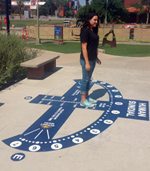 |
Tucson |
Arizona |
USA |
Analemmatic Dial |
Dial 825 |
| This nearly 14-foot wide analemmatic human sundial replaces the previous sundial at the same location. The previous dial by an unknown designer had several design errors and was in poor condition. The Flandrau Planetarium replace it, choosing a sundial with a blue background and white hour numerals. Dial Markings include quarter hour marks, Solar Noon Mark, Date Line with one week marks, Alignment Marker for Sunrise and Sunset (Bailey Points) with Solstice and Equinox lines, and the four Cardinal Points of the compass. The dial has a built-in longitude correction and shows Mountain Standard Time when readings are adjusted for The Equation of Time |
| |
| |
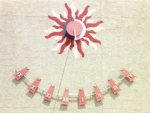 |
Tucson |
Arizona |
USA |
Vertical Dial |
Dial 456 |
| This is a 10 x 10 foot south vertical wall dial with hour lines painted on the wall that are corrected for longitude. A unique feature of this dial is the time scale can be rotated forward or back slightly to compensate for the Equation of Time. However, because only the hours are marked, precise minute reading is difficult. Welded steel was used to make the time marker ring and gnomon. |
| |
| |
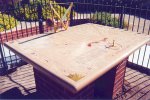 |
Tucson |
Arizona |
USA |
Horizontal Dial |
Dial 464 |
| A horizontal sundial 45 x 61 inches with a monofilar brass cable gnomon and tension counterweight. This is the largest horizontal sundial in the US carved on a single piece of stone, taking two years to build. The dial has hour lines from 5am to 8pm, corrected for longitude. Each hour line has an analemma and in the lower right of the dial is a graph of the Equation of Time. A nodus on the wire gnomon indicates date, with declension lines for summer and winter solstice, equinox, and date lines. Time and direction of sunrise and sunset are marked on the equinox and solstice lines. At the base of the gnomon is a 16-point compass rose. On the left side of the dial is a table for telling time by moon shadows. In the center is a copy of the hands from "The Creation" by Michelangelo. |
| |
| |
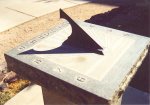 |
Tucson |
Arizona |
USA |
Horizontal Dial |
Dial 465 |
| A simple square horizontal dial 20 x 20 inches carved in a 3 inch block of granite with a bronze gnomon. The dial has hour lines from 6am to 6pm for local solar time. No graph or table for longitude and Equation of Time corrections. Dial sits atop a 3 foot square pedestal. |
| |
| |
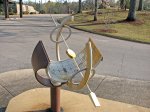 |
Tuscaloosa |
Alabama |
USA |
Equatorial Dial |
Dial 189 |
| A 5 foot bronze and steel equatorial dial with pinhole gnomon in front of the North River Yacht Club. |
| |
| |
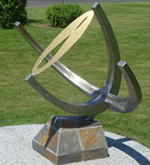 |
Twin Falls |
Idaho |
USA |
Equatorial Dial |
Dial 839 |
| This beautiful stainless steel equatorial is approximately 1m in diameter with brass inlay for the equatorial time, divided down to the minute. This is also an analemmic sundial where the brass gnomon is cut out in the shape of an analemma allowing the user to directly correct for the equation of time. The analemma is marked with 365 individual date marks. |
| |
| |
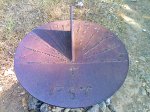 |
Ukiah |
California |
USA |
Horizontal Dial |
Dial 624 |
| A horizontal dial of welded steel plate using weld bead for hour lines and numerals. Marked for PST. |
| |
| |
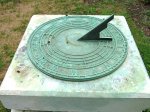 |
Urbana |
Illinois |
USA |
Horizontal Dial |
Dial 289 |
| Horizontal dial 14 inches diameter, with 5 inch tall gnomon. Sits on stone pedestal 40 x 40 x 42 inches. |
| |
| |
 |
Vail |
Arizona |
USA |
Analemmatic Dial |
Dial 599 |
| A brass and concrete analemmatic dial set in the Butterfly Garden at Colossal Cave Mountain Park at 3415 feet elevation. The dial is 21 feet E-W across the hour markers. A hand-held rod gnomon 143 inches long includes a bubble level for positioning. There is a modest park use fee to view this dial. |
| |
| |
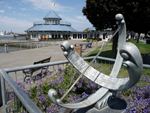 |
Vallejo |
California |
USA |
Equatorial Dial |
Dial 235 |
| A 5-foot equatorial sundial with elegant time and meridian supporting arcs. The gnomon A 5 ft. aluminum polar dial. The gnomon has the profile of the Golden Gate Bridge. Time is marked in both standard and daylight saving time with Roman numerals. The dial was a gift from Vallejo's Sister city, Akashi, Japan. |
| |
| |
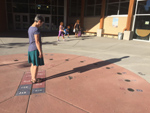 |
Vancouver |
British Columbia |
Canada |
Analemmatic Dial |
Dial 927 |
| The analemmatic sundial is laid within a 15-foot circle of light red concrete, set in the middle of a large grey concrete concourse on the south side of the school. Hour points are marked by 4-inch bronze disks embedded in the concrete; the declination scale is made of embedded tiles. The scale is red in part and blue in part, denoting the summer and winter periods. Correspondingly, each hour point hour is labeled twice; red for Daylight Saving Time and in blue for Standard Time. The dial incorporates a longitude correction for the time zone, and features Sunrise & Sunset Markers ("Bailey Points"). All labels were hand-painted by students - a deliberate measure intended to require occasional repainting and hence continued student engagement and involvement with the dial over the years. |
| |
| |
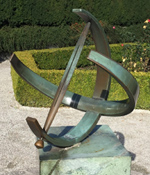 |
Vancouver |
British Columbia |
Canada |
Equatorial Dial |
Dial 931 |
| A simple but elegant and well-executed bronze equatorial dial by renowned local sculptor Gerhard Class. It is about 24-inches in diameter and is mounted on a 16 x 16 x 36-inch plinth of nephrite jade, damaged at one corner. The gnomon has a central slit and can be rotated about the polar axis to create a narrow beam of light for precise reading of the sun's position. The dial shows local solar time plus one hour, corresponding to Daylight Saving Time. The dial's construction is technically perfect but, sadly, the dial appears to be misaligned with the gnomon axis pointing 7 deg west of north. |
| |
| |
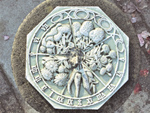 |
Vancouver |
British Columbia |
USA |
Horizontal Dial |
Dial 932 |
| This was once a very beautiful sundial sitting on a short concrete pedestal. Now it has a missing gnomon and the dial color is uniformly aquamarine except where the coating has been rubbed away to reveal a white substrate. Tapping the dial face makes a dull sound suggesting the dial is not metal and may be hollow. A possible explanation is that the dial could be made of some kind of cast resin or fiberglass and was then spray-painted. The dial face itself is elegantly sculpted into five sectors, showing clusters of flowers, berries and fruits, creating a pronounced 3D effect. Because of this, the hour lines are reduced to short ticks at the edge of the dial face. The dial shows solar hours, marked off using Roman numerals. |
| |
| |
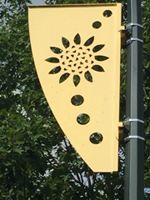 |
Vancouver |
British Columbia |
Canada |
Sculpture/Artwork |
Dial 990 |
| This artwork along Prince Edward street stretches about 1.5 mile (2.4 km). The latitude and longitude are given for the mid point. As public art the installation is know as Solar Patterns I and II. They are a collection of metal banners attached high on street poles and at eye level, an explanation of the pattern in the banner. Each banner consists of a yellow or orange aluminum sheet perforated with round holes representing the sun following a simple curve that is part of the analemma. The third dot from the top of the banner is replaced by an image of the sun as conceived by various artists ranging from school children to iconic images from various cultures to historic representations of the sun from cave paintings. |
| |
| |
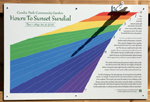 |
Vancouver |
British Columbia |
Canada |
Hours to Sunset |
Dial 919 |
| This bright and colorful vertical dial declines west, showing "Hours to Sunset" (Italian hours). The dial is held up by two posts on a board 60 x 90 cm (24 x 36 inches). The dial face is decorated in the colours of the rainbow, with a band of color for each hour left to sunset. Quarter hours are marked using thin white lines. The dial was commercially printed on aluminum-plastic laminated material, with a UV protective coating. The gnomon is a repurposed decorative gate hinge. The supporting structure is made from red cedar. |
| |
| |
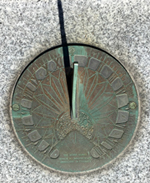 |
Vancouver |
British Columbia |
Canada |
Horizontal Dial |
Dial 920 |
| This is a 25 cm horizontal dial engraved on a 1/4 inch yellow metal plate (probably bronze). It shows local solar time. The hour marks look precise and consistent, but upon closer look are oddly arranged. The dialist attempted to shift the dial hour lines to correct for longitude (3.17 deg west). The AM hour lines are fairly accurate except the earliest hour lines (IV, V) which inconsistently meet the gnomon foot on the wrong side. The PM hour lines seem to mirror the AM lines except that 3 degrees had been added to each, rendering inaccurate time throughout the afternoon. The gnomon is slightly bent, and nearby buildings and trees block the dial at some times of day. The dial is decorated using simple geometric and visually pleasing patterns. Shallow engraving is used for the hour lines (making them a bit difficult to read), labels, and decoration. The gnomon has a bird engraved on each side and sits on a wedge base. The dial sits on a short granite pedestal with a polished top surface, and was commissioned by his parents in memory of Robert Carlyle Howard (born 1953, died 1970). |
| |
| |
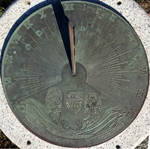 |
Vancouver |
British Columbia |
Canada |
Horizontal Dial |
Dial 925 |
| A delightful dial in a delightful setting, well worth the modest admission fee. It is an 18 inch patinated bronze disk mounted on an elegant white granite pedestal, with the hours adjusted to the time zone. The face is a finely crafted bas relief delineated in quarter hours, with the hours labeled using Roman numerals. The lower part of the dial shows the Arms of UBC, along with the leaves and flower spikes of a plant. In keeping with the medicinal purpose of a Physic Garden, the sculpted gnomon features a snake (a traditional symbol for a physician) entwined around a poison chalice (a traditional symbol for a pharmacist). A plaque on the pedestal dedicates the dial to Frank Ebenezer Buck, 1876 - 1970, UBC’s first Landscape Architect. The pedestal is from the 1920s, predating the dial, and was used elsewhere in the Botanical Gardens for their now-lost original sundial. |
| |
| |
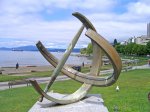 |
Vancouver |
British Columbia |
Canada |
Equatorial Dial |
Dial 645 |
| A 30 inch diameter bronze equatorial dial. A slot in the rotatable gnomon project a line of sunlight onto the equatorial ring displaying Arabic hour numerals. Dial is corrected for longitude. Dial is mounted on a 53 inch high stone pedestal. This dial is also known as the George Cunningham Memorial Sundial as it was sponsored by the Cunningham Drug Stores to commemorate the opening of their first store in 1911 at a nearby corner. |
| |
| |
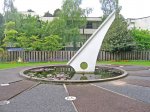 |
Vancouver |
British Columbia |
Canada |
Horizontal Dial |
Dial 648 |
| A large concrete and pebble horizontal dial with a 30 foot high gnomon. Hour lines are wood dividers in concrete with Roman numeral hour markers. Dial center and gnomon are situated in a lily pond.
Dial is on private property but is fully visible from public street. |
| |
| |
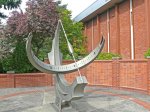 |
Vancouver |
Washington |
USA |
Equatorial Dial |
Dial 659 |
| A 2 meter diameter ring equatorial dial of welded anodized aluminum plate. The dial face shows Arabic numerals with hour and quarter-hour marks. This face can be moved for longitude correction and DST, and was originally adjusted to correct periodically for EOT. In 2009, the original straight gnomon was replaced with an analemmic gnomon, eliminating the need to adjust or correct for EOT. |
| |
| |
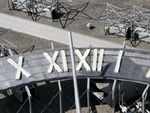 |
Vancouver |
British Columbia |
Canada |
Horizontal Dial |
Dial 1099 |
| This is intended to be a horizontal sundial, but positioned poorly and viewed by nearly no one.. The chapter ring is marked out in Roman numerals running from V (am) to IV (pm) on a large semi-circular arc of open metalwork supported by a trellis structure. It is very large, about 40 meters across. The gnomon is a separate structure and is not positioned or oriented correctly. |
| |
| |
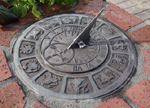 |
Ventura |
California |
USA |
Horizontal Dial |
Dial 1007 |
| The central part of the bronze sundial, approximately 12 inches in diameter, has the traditional hour marks and divisions into 15 minute intervals and surrounded by Roman numerals from 5am to 7pm. South of the gnomon is a simple compass rose with four cardinal points. With the dial at ground level the gnomon has led a hard life and is now held to the dial plate with improvised brackets. Surrounding the dial, doubling the size to 24 inches in diameter is an elegantly engraved ring of the twelve figures of the zodiac, each named on the outer ring with the corresponding month on the inner ring. |
| |
| |
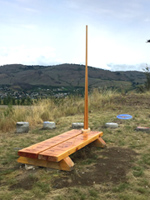 |
Vernon |
British Columbia |
Canada |
Analemmatic Dial |
Dial 933 |
| This is a standard outdoor analemmatic dial located on a hillside allowing all-day illumination and providing good views of Vernon and the surrounding area. The layout was designed by James Kanester. Rather than acting as a "Human Sundial" this analemmatic uses a movable vertical pole that sits in a slot in the declination scale. A central figure-8 analemma curve provides an indication by date where to place the gnomon in the slotted meridian grove. The declination scale, designed and constructed by Joel Wrinch, is wooden with engraved lettering and analemma. The dial's hour marks are concrete posts, topped by glass mosaics made by local artist Connie Vetter-Johnson. Only whole hours are marked. Dial furniture includes a larger glass mosaic image of a hawk. The dial's major axis is about 22 feet, the declination scale is about 6 feet long, the hour markers are 12 inches in diameter. The hawk mosaic is about 18 inches in diameter. |
| |
| |
 |
Victoria |
British Columbia |
Canada |
Horizontal Dial |
Dial 1046 |
| An ordinary mass-produced horizontal dial mounted on a simply decorated cast concrete pedestal. 11.5" diameter, cast iron with verdigris finish. The dial face is inclined but in the wrong direction, opposite to what is needed to properly align the style to the polar axis (cannot be corrected because fixture is damaged). Appears to be a Model #2550 'Father Time' dial from Rome Industries. |
| |
| |
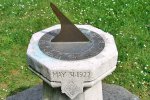 |
Victoria |
British Columbia |
Canada |
Horizontal Dial |
Dial 572 |
| A replica 12-inch bronze horizontal dial on a concrete plinth. This dial is a memorial for Marjorie Napier, a twelve-year-old St. Ann's student who died on 31 May, 1922. The original dial and limestone plinth were moved to Queenswood, a private retirement home for elderly nuns and seniors. A plaque for the replica dial reads, "In memory of Una Holm (Robertson) Class of 1928. Thank you the Sisters of St Ann's, the strength of Sister Eleanor Marie and the Rock which was St Ann's Academy. Replica sundial donated by husband Sandy E S A Holm and their daughter Karen Michaelson (Holm) Class of '53." |
| |
| |
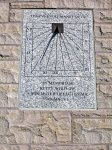 |
Victoria |
British Columbia |
Canada |
Vertical Dial |
Dial 575 |
| A 30x20-inch vertical dial declining 7° 33' west of south made of granite inset in a stone wall. A memorial dial for Betty Whitlow commissioned by Dean Brian Whitlow. Inscribed, "IN MEMORIAM BETTY WHITLOW, UXOR MATER DELICTISIMUA, MCMXCVI." Information on EOT and longitude corrections are available just inside the south door of the cathedral. |
| |
| |
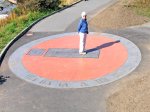 |
Victoria |
British Columbia |
Canada |
Analemmatic Dial |
Dial 663 |
| A 20 foot overall tinted concrete analemmatic dial with brass numerals, aluminum and granite slabs. Distance between major axis and small hour marks is 16.4 feet. Brass Roman numerals 10 inches high are set in a grey outer ring. Longitude and EOT corrections are marked beside the monthly date marks. A plaque commemorating the British Columbia 150 year celebration includes instructions on use and information on the dial designers and sponsors. |
| |
| |
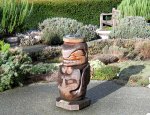 |
Victoria |
British Columbia |
Canada |
Horizontal Dial |
Dial 752 |
| A bronze horizontal dial with hour lines, quarter-hour marks and Roman hour numerals. Dial face includes a central compass rose. The dial sits atop a carved cedar totem depicting an Orca killer whale. The totem is carved in the Coastal Salish tradition by Aubrey LaFortune, a member of the Cowichan Band of native Canadians. |
| |
| |
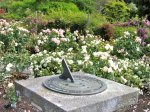 |
Victoria |
British Columbia |
Canada |
Horizontal Dial |
Dial 753 |
| A 12 inch diameter cast bronze horizontal dial with hour lines, quarter-hour marks and Roman hour numerals. Dial face includes a central compass rose with cardinal directions. The dial sits atop a cast concrete pedestal sculptured with curves, fronds and cherubs. However the dial may be misaligned from true North. The gnomon angle appears close to the dial's latitude (measured at 49.2°). |
| |
| |
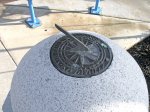 |
Victoria |
British Columbia |
Canada |
Horizontal Dial |
Dial 754 |
| A 9 inch diameter cast bronze dial with hour and half-hour marks and Roman hour numerals. The dial face has a compass rose at the center with cardinal and ordinal directions. The casting is of poor quality and the gnomon, brazed in place, is bent and at the wrong angle.
The sundial is a monument to the Point Hope Shipyard. Engraved on one side is the history of the shipyard, the oldest in British Columbia, renovated and reopened in 2007. The cast dial pedestal is marked, "This newel post was saved from the demolition of St. Mary's Hospital, Victoria. |
| |